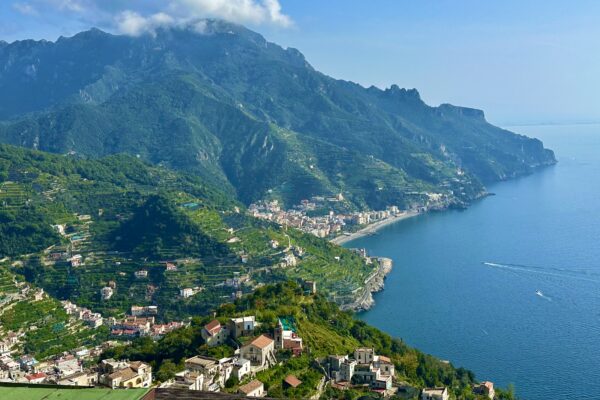Athena’s City

text & photos by Marla Norman, Publisher for Travel Curious Often
At this juncture of its 9,000-years-plus life span, Athens is not a city you fall in love with immediately. The pollution is thick. Glorious Mount Lycabettus, the highest point in the region, is often barely visible. Snarled traffic and endless tourist busses don’t add to a first impression. Graffiti mars many of the classic buildings and once exquisite statues.
Taxiing into the city, however, we find our driver is utterly charming. He takes us on a quick tour that includes the Greek Parliament, public gardens and pretty side streets. By the time we arrive at our hotel in Plaka, a central neighborhood in Athens, we’ve acquired an appreciation for the ancient city.
Then the grand moment – we’ve just checked into our room, stepped out onto the balcony and suddenly behold the Acropolis! The enduring beauty and grandeur of the site is undeniable. Within seconds, Athena has us wrapped in her spell.
Later that evening, we dine on the rooftop terrace of our hotel, the Electra Palace. Transfixed, we watch the sun set behind the Parthenon. Then, as the twilight fades, lights spectacularly illuminate the Acropolis. We are officially infatuated with Athens.
GREEK THEATRICS
The next morning, we get right to it, meeting up with our guide — an archeologist named Aristotle (of course!) — to tour the Acropolis and the Acropolis Museum. NOTE: We booked through Athens Walking Tours
Our first stop is the Theater of Dionysus at the base of the Acropolis. Stone seats and long rows still stretch out along the amphitheater, which once held over 15,000 spectators. Aristotle helps us to imagine the spectacle of the Dionysian Festivals during 6th century BC, featuring fierce competition between dramatists such as Sophocles for his Oedipus Rex and Euripides for Medea. We feel the goosebumps….western civilization began here!
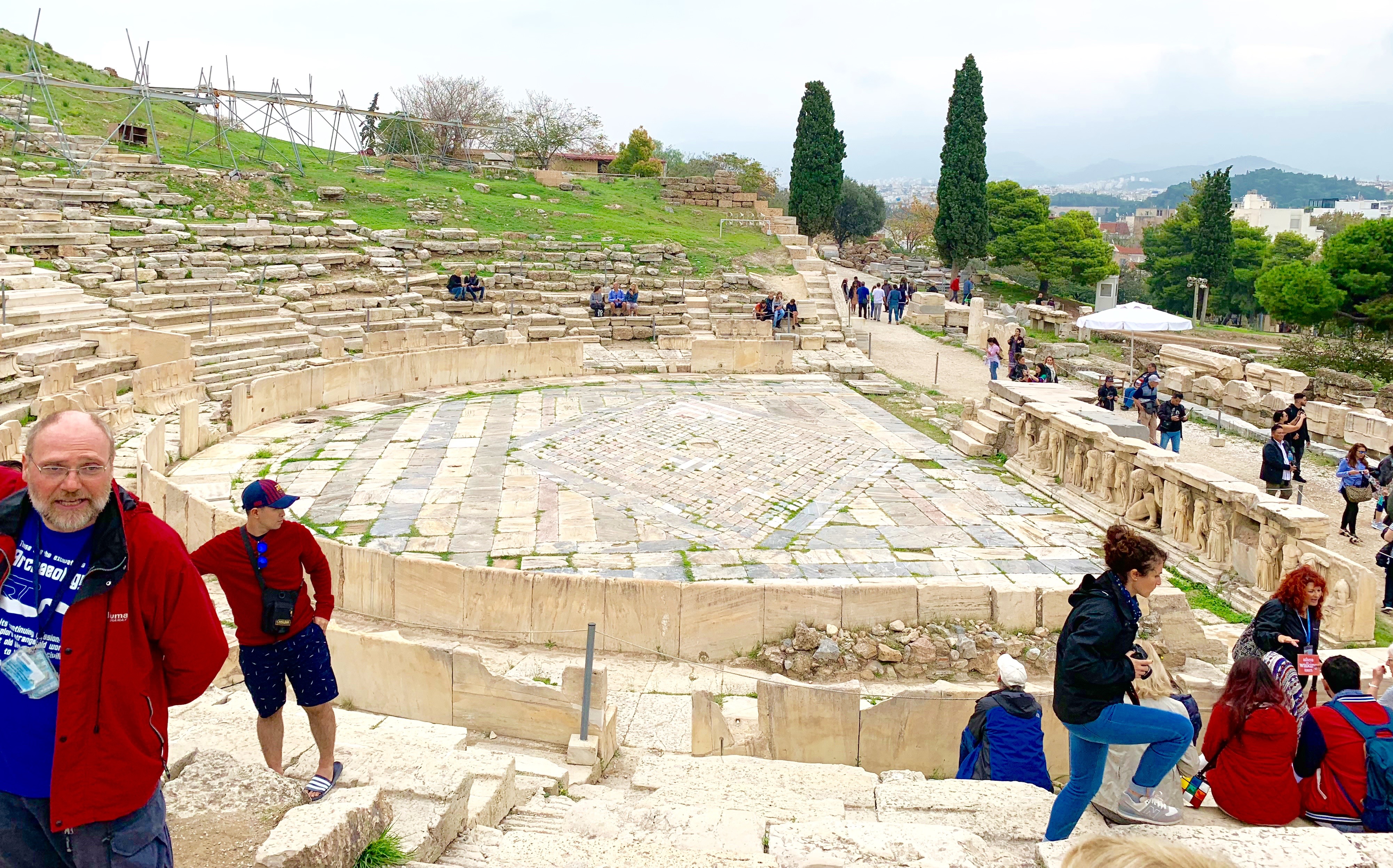
The Theater of Dionysus once held over 15,000 spectators who watched dramatists such as Sophocles and Euripides compete. Photo by Marla Norman
From the Dionysus Theater, we walk a short distance to the Odeon of Herodes Atticus Theatre. Still very much in use, the theater was originally built in 161 AD during the Roman occupation of Greece. Restored in the 1950’s, the site has hosted numerous cultural events and performers, ranging from Frank Sinatra and Luciano Pavarotti to Elton John.
Aristotle explains that Herodes Atticus, a Greek aristocrat who also served as a Roman senator, founded the theater to honor his wife. The poor woman died suddenly, under very mysterious circumstances. More intriguing, is that she was some 26 years younger than Atticus. So did the influential senator build the theater out of grief for the death of his young wife? Or, as historians suspect, to reconcile with her powerful Roman family for some dark misdeed? We’ll never know. But clearly, Greek dramatists had plenty of great material to draw from as they scripted their plays.

Originally built in 161 AD, the Odeon of Herodes Atticus Theatre has been restored and in use since the 1950s. Photo by Marla Norman.
ALL ABOUT THE ACROPOLIS
We continue our climb up to the Acropolis itself. We’ve learned, literally, that Acropolis means “High City.”
Once we’ve passed through the impressive Propylea, monumental gate, we are officially on the flat-top limestone outcrop of the Acropolis, some 512 feet above Athens itself. Here, the Parthenon dwarfs everything. At 228 by 101 feet (69.5 by 30.9 meters), it is a massive structure.
But Aristotle leads us first to a smaller temple, the Erechtheion. Famous for the six lovely maidens who serve as support columns for the building’s roof, this structure was completed in 406 BC.
Aristotle explains that the Erechtheion, not the Parthenon, is the most sacred site and the cornerstone of Athenian history. Here, according to legend, Poseidon and Athena competed for control of the region.
On this spot, Poseidon plunged his trident into a rock and produced a spring of water. Athena, determined to out-do him, created an olive tree, whose fruit became a stable of Greek life. A panel of judges declared Athena the winner and named the capital in her honor. Her gnarled olive tree still grows near the temple…or so they say.
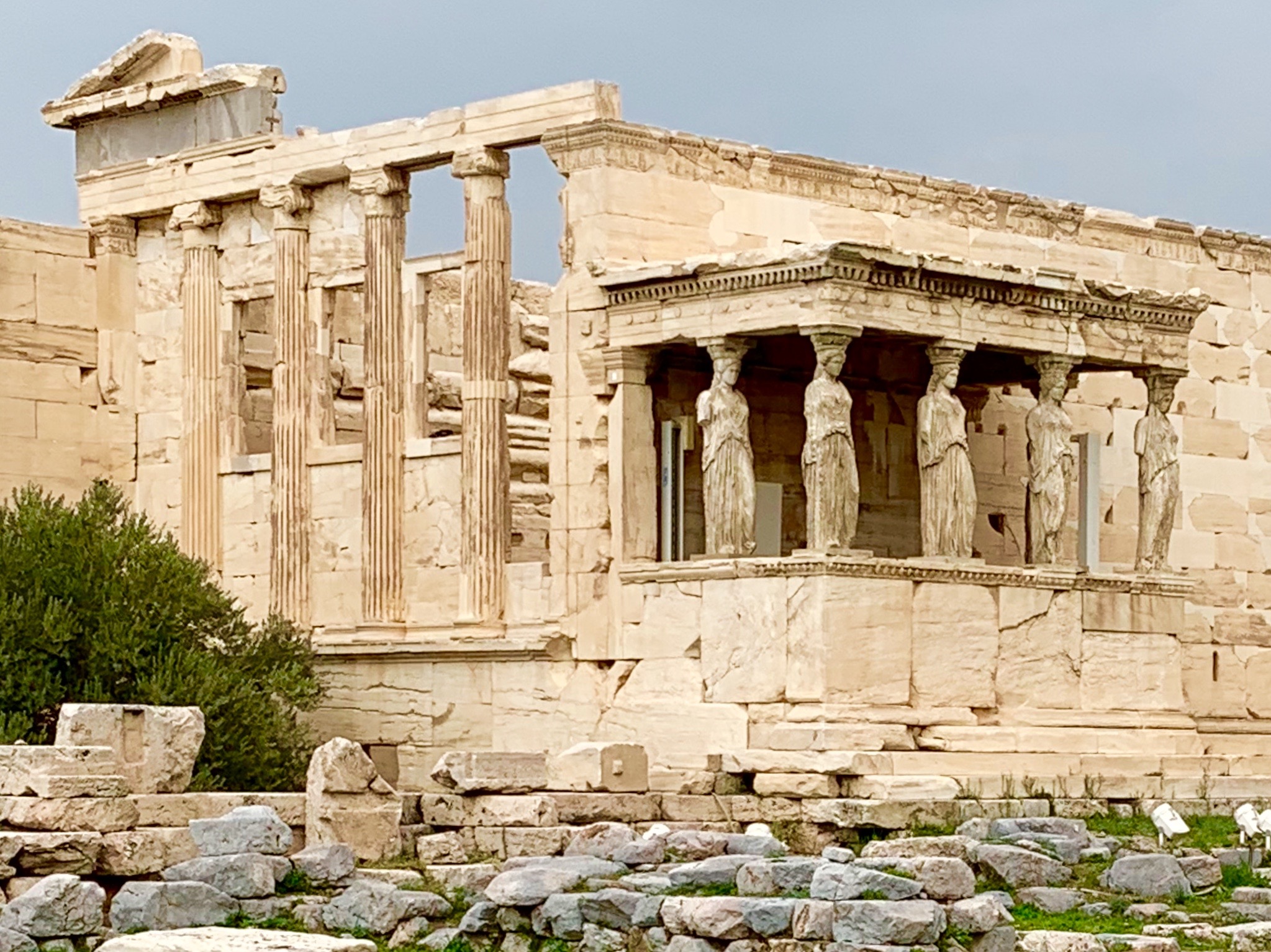
The Erechtheion Temple, with its six sculptured maidens. Athena’s mythical olive tree still grows nearby. Photo by Marla Norman.
Finally moving on to the Parthenon, we’re again amazed by the colossal size of the temple. Constructed between 447 and 438 BC by the legendary Athenian general-statesman Pericles, the building was ostensibly dedicated to Athena. However, it primarily served as the treasury for the Delian League — an alliance of cities, including Sparta, who had banded together to defeat the Persians.
The Parthenon consists of 8 columns on the east and west and 17 on the north and south with a walled interior chamber. Originally smaller Doric colonnades divided the space. It’s impossible to overstate the extraordinary achievement the Parthenon represented at the time — not only because of its extraordinary size, but for the perfection of its proportions and architectural inventions.
To cap off the site, the brilliant sculptor Pheidias created a stupendous bronze statue of Athena. At 30 feet (9 meters) it was one of the largest sculptures in antiquity and could be seen from the sea.
The Acropolis remained intact until the 5th century BC when the Parthenon was transformed into a Christian church and the great statue of Athena was removed. The Turks seized Athens in 1458 and converted the Parthenon to a mosque. In 1687, Venetians fought the Turks for control of the city and a powder magazine located in the temple blew up, destroying the central chambers. It’s safe to say, the Acropolis has seen a good bit of history.
ACROPOLIS MUSEUM
From the Parthenon, Aristotle escorts us to the Acropolis Museum, a beautifully-desiged contemporary building dedicated in 2009. It’s here that the surviving treasures from the Acropolis have been assembled — sculptures, marble decorations, masks and vases. An astounding display of sculpture uses technological wizardry to recreate the vibrant colors that were original to the work — they weren’t all just beige!
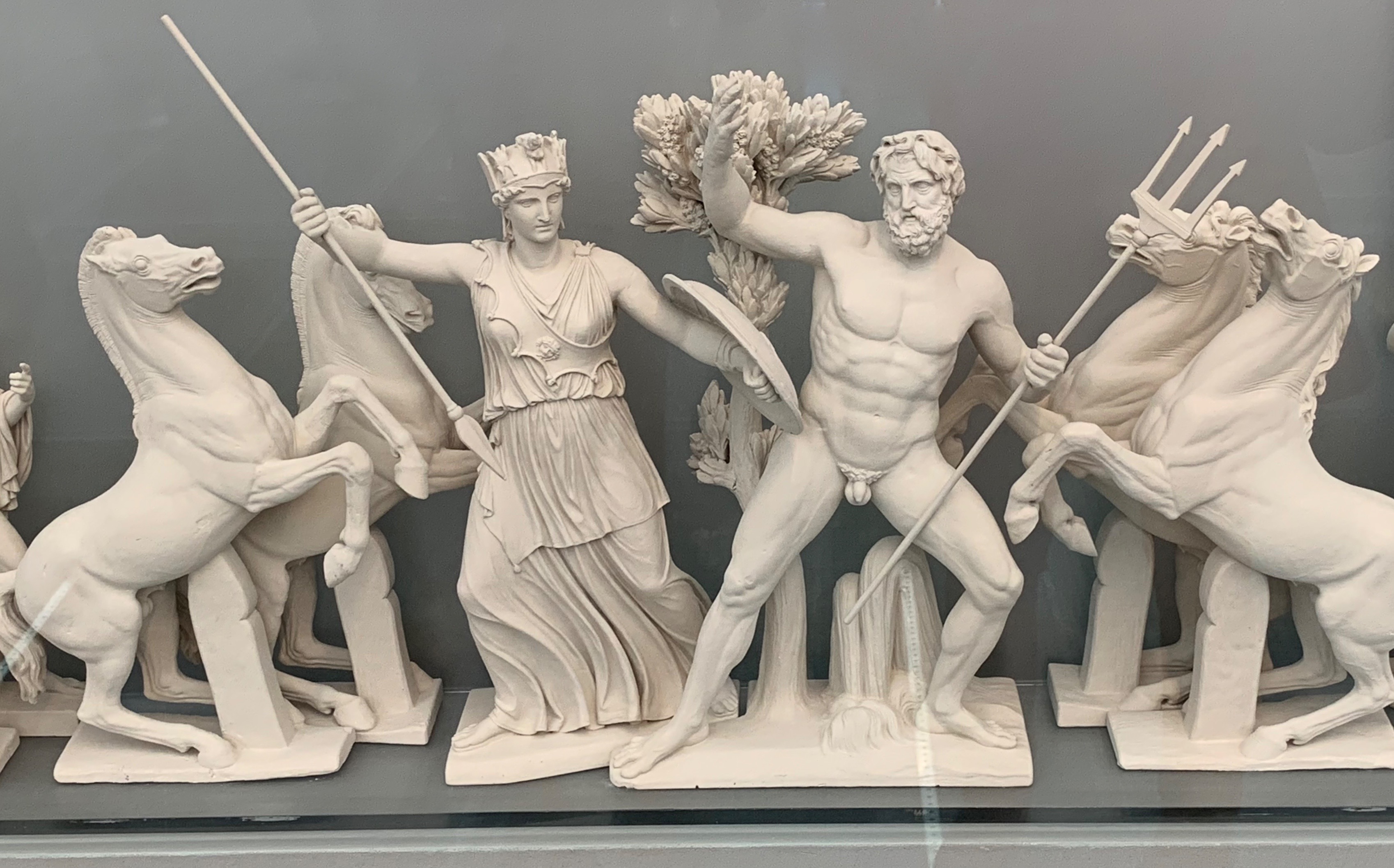
At the Acropolis Museum, a replica of the famous competition between Athena and Zeus. Photos by Marla Norman
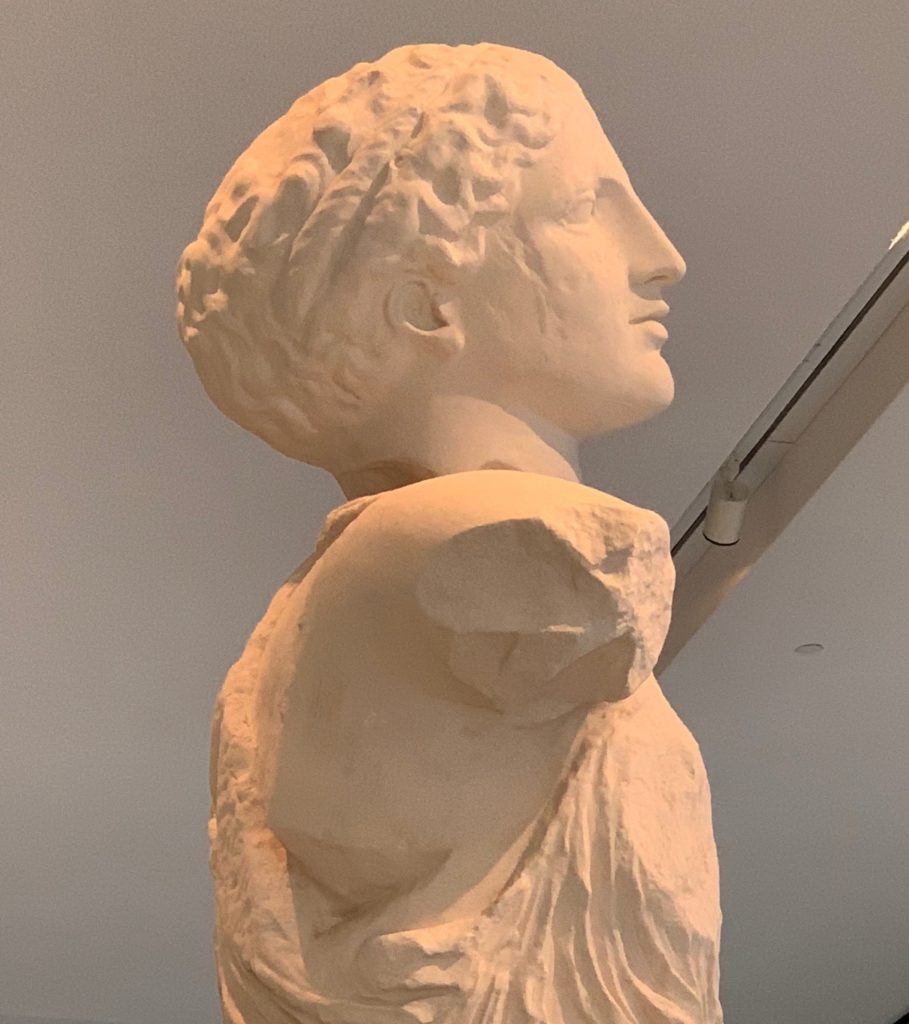
Many of the surviving sculptures from the Acropolis have been assembled at the Acropolis Museum.
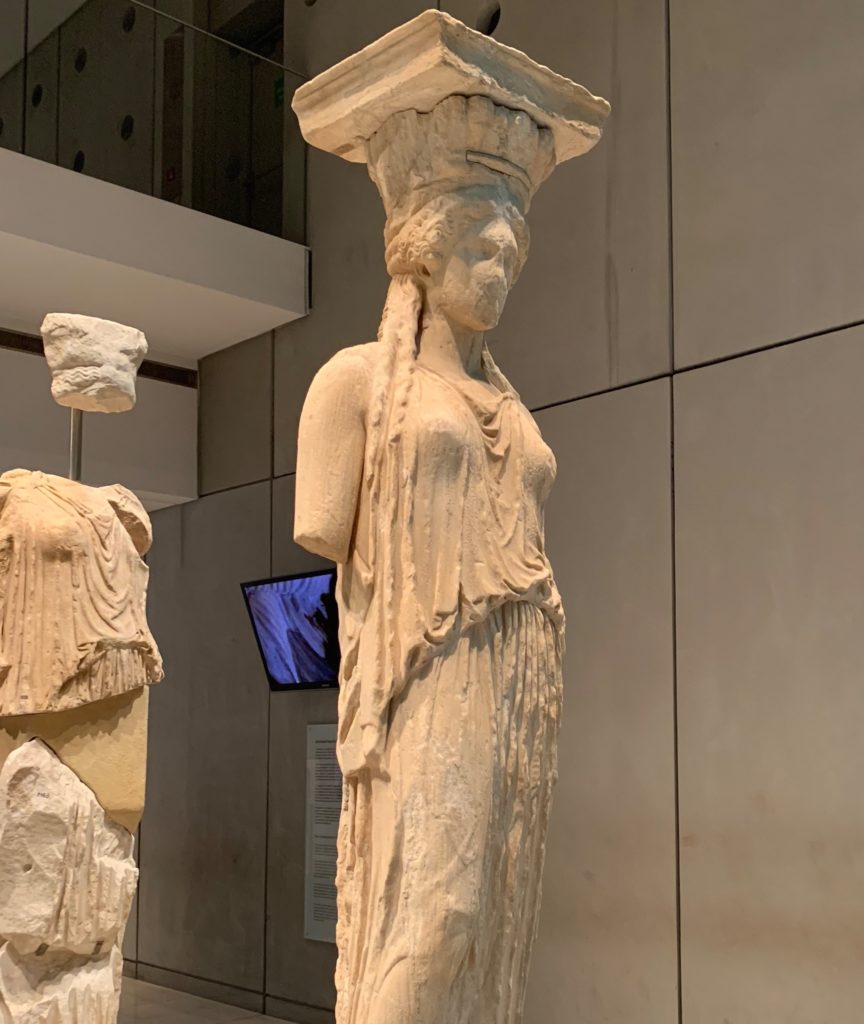
Also fascinating is that the museum has been built over an on-going archeological dig. Glass floors allow visitors to observe the tasks in progress, such as the reconstruction of mosaics, assembling pottery shards, uncovering foundations, etc.
The top floor atrium has been recreated in the proportions of the Parthenon to display the magnificent Pentelic marble decorations. We notice, however, that there are a number of empty spaces. Aristotle tells us that a large number of sculptures were removed by the British archeologist Thomas Bruce, Lord Elgin and sold in 1816 to the British Museum in London. “We sincerely hope the museum will return these Greek works of art to the Greek people,” Aristotle concludes with understandable passion. We couldn’t agree more!!!
BYZANTINE & CHRISTIAN MUSEUM
One of the largest collections of Byzantine art is on display at the Byzantine & Christian Museum. Particularly interesting is that the museum documents the expansion and collapse of the Byzantine Empire, a part of history often ignored in western cultures.
At its height, between 527-565 AD, the Byzantine Empire included not only Greece, eastern Europe, the Middle East and North Africa, but Italy as well. Most of the civilized world spoke Greek at this time; in fact, Koine Greek was the original language of the Christian New Testament.
In later centuries, attacks by Ottoman Turks were devastating, but the Empire managed to survive until the 12th century when Constantinople was destroyed during the Fourth Crusade. The split between Orthodox Christianity and Catholicism had come years earlier in 1054.
Today, the Greek Orthodox Church, the last remnant of the Byzantine Empire, is still the predominant religion in Greece, the Balkans, Russia, the Ukraine and some parts of the Middle East. The distinctive religious art continues to be an integral part of the culture and has, of course, evolved throughout the centuries. Half of the museum collection is devoted to more than 1,500 artworks dating from these latter periods, the 15th to the 21st century.
We spent a half-day in the museum, dazzled by the fabulous art, and left feeling as if we had a better understanding of world history as well.
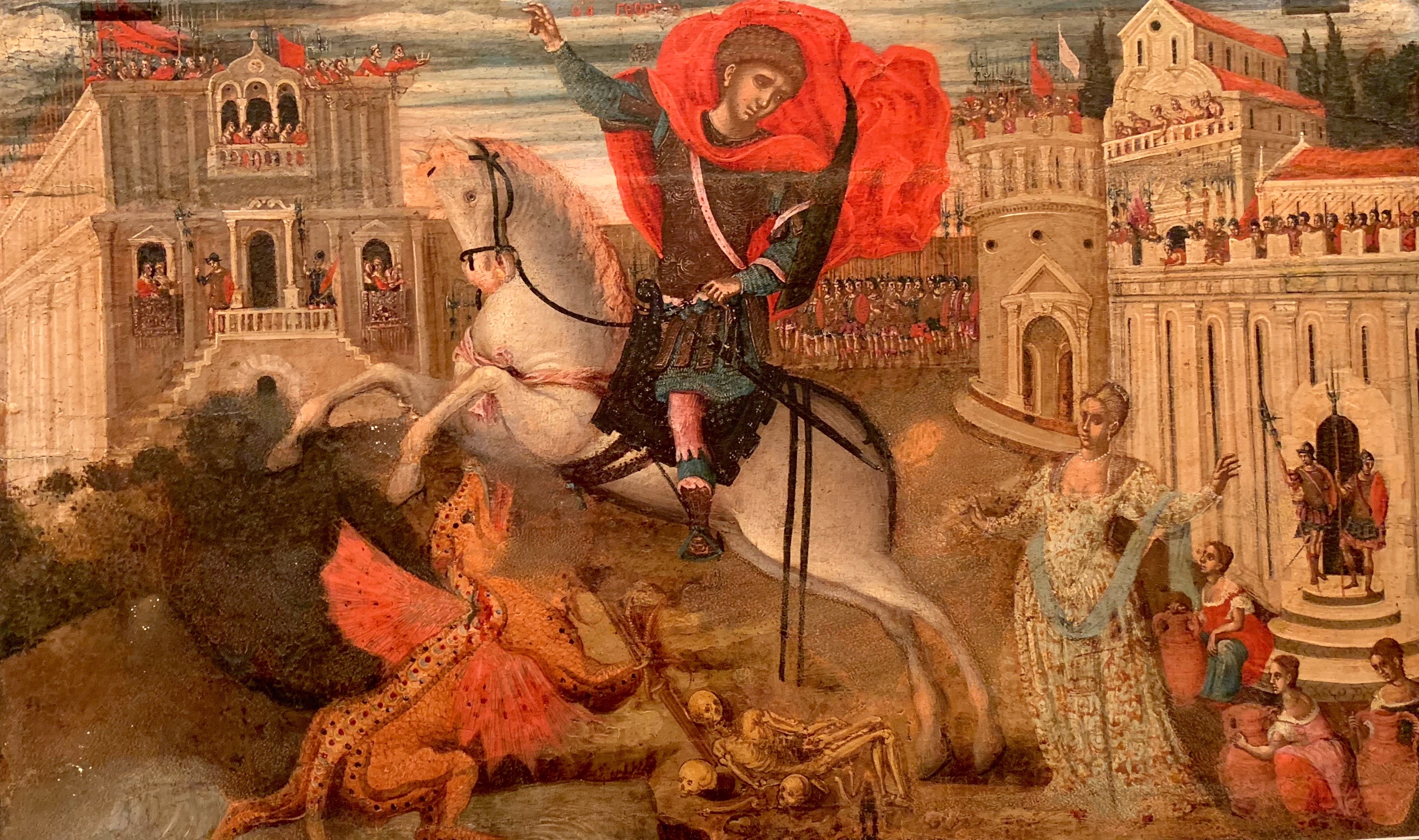
Saint George the Dragon-Slayer by Georgios Klontzas, 16th century. Depicted here is King Selvios of Alagia (Venetian Crete) the princess’s father. He and her mother hold the crown and the keys of the city, ready to offer them to the saint, expressing their gratitude.
Icon of Saint Catherine, painted by Viktor, mid-17th century. Photos by Marla Norman. Archangel Michael – icon produced by a religious workshop based in Constantinople during the first half of the 14th century.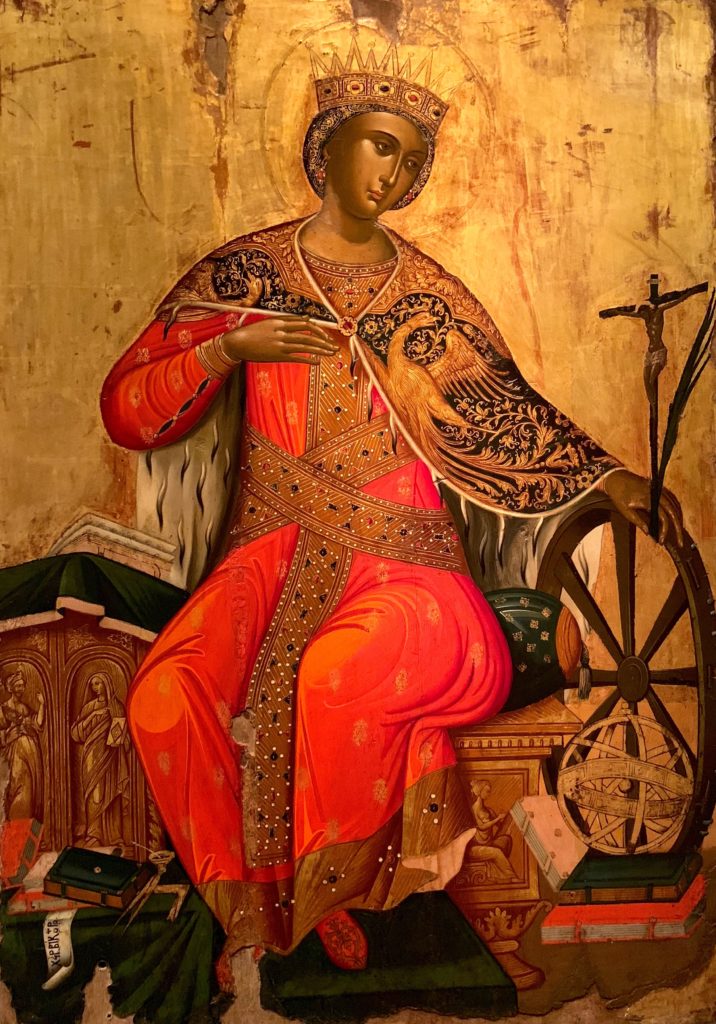
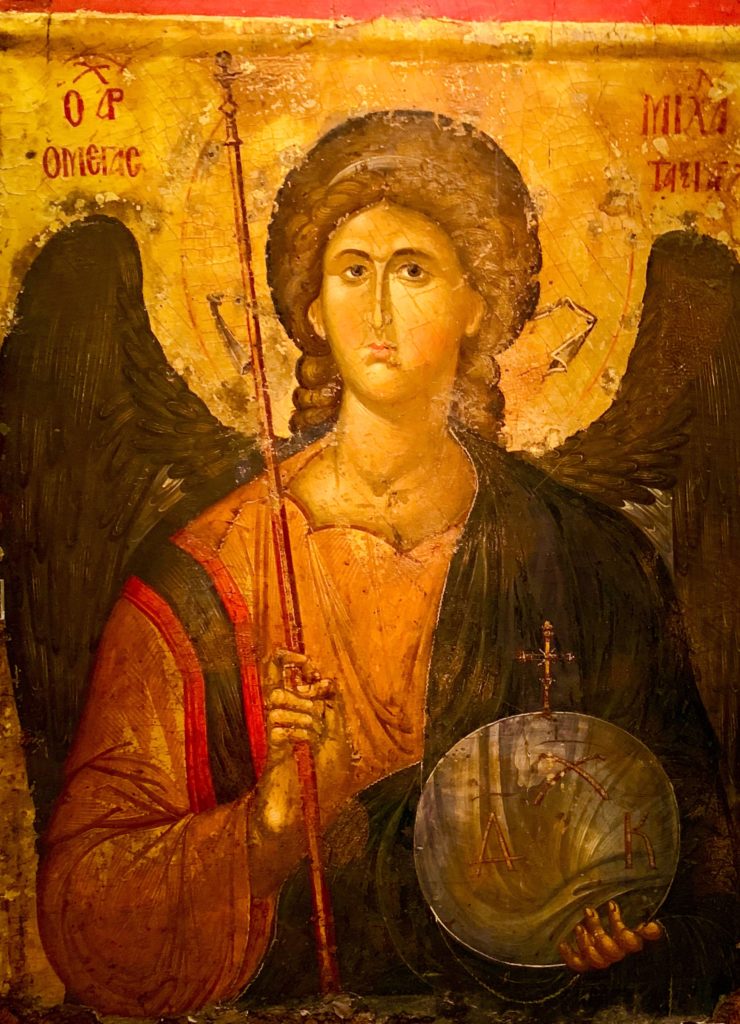
PARLIAMENT & PRESIDENTIAL GUARDS
If you happen to be in Athens on a Sunday, you’re in for a treat! At precisely 11:00 a.m., in front of the Hellenic Parliament, you can observe the formal changing of the Presidential Guards — a fascinating and colorful ceremony. If you’re not in the city on a Sunday, don’t despair. You can also observe the guards every hour on the hour, Monday through Saturday. Weekday rituals are less formal and smaller, but still very much worthwhile.
The Presidential Guard is made up of a special unit within the Hellenic Army known as the Evzones. This group is always on duty at the the Monument of the Unknown Soldier in front of the Hellenic Parliament and the Presidential Mansion.
The uniform of the Evzones seems quite odd on first encounter: skirts, known as foustanella kilts, shoes with large pom-poms, hats with extra-long tassels. But, each element in the uniform has a historical context referencing the Kleftes and Armatoloi, two groups of Greek warriors who fought during the War of Independence in 1821 against the Ottomans. Indeed, the white skirt of the uniform has 400 folds to represent the 400 years of Ottoman occupation over the Greeks.
During the changing of the guard, soldiers work in pairs to coordinate their movements. Each ceremonial step is made in slow motion. These precise, slow maneuvers are designed to protect the soldiers’ blood circulation after an hour of immobility on guard.
Be sure to arrive a bit early to watch. The ceremony is a popular tourist attraction and you may also have to compete with enthusiastic protesters for a good viewing spot.
GREEK RESTAURANTS & WINE BARS
While touring Athens, we frequently found ourselves dizzy with facts, data and century upon century of Hellenic, Roman and Byzantine history. During those moments, we’d escape to the city’s excellent restaurants and wine bars. Below a few of our favorites, primarily in the Plaka neighborhood.
Eat at Milton’s
Adrianou 91
In spite of the campy sounding name, Eat at Milton’s is beautifully designed, with an outdoor terrace, romantic candlelight and interior alcoves for more private dining. The menu, primarily seafood, is excellent as are the traditional Greek dishes, such as Moussaka and lamb. There is also a wide selection of good wine and cocktails. Best of all, the staff is especially personable and attentive. We had dinner there twice (once to celebrate Michel’s birthday) we loved it so much!
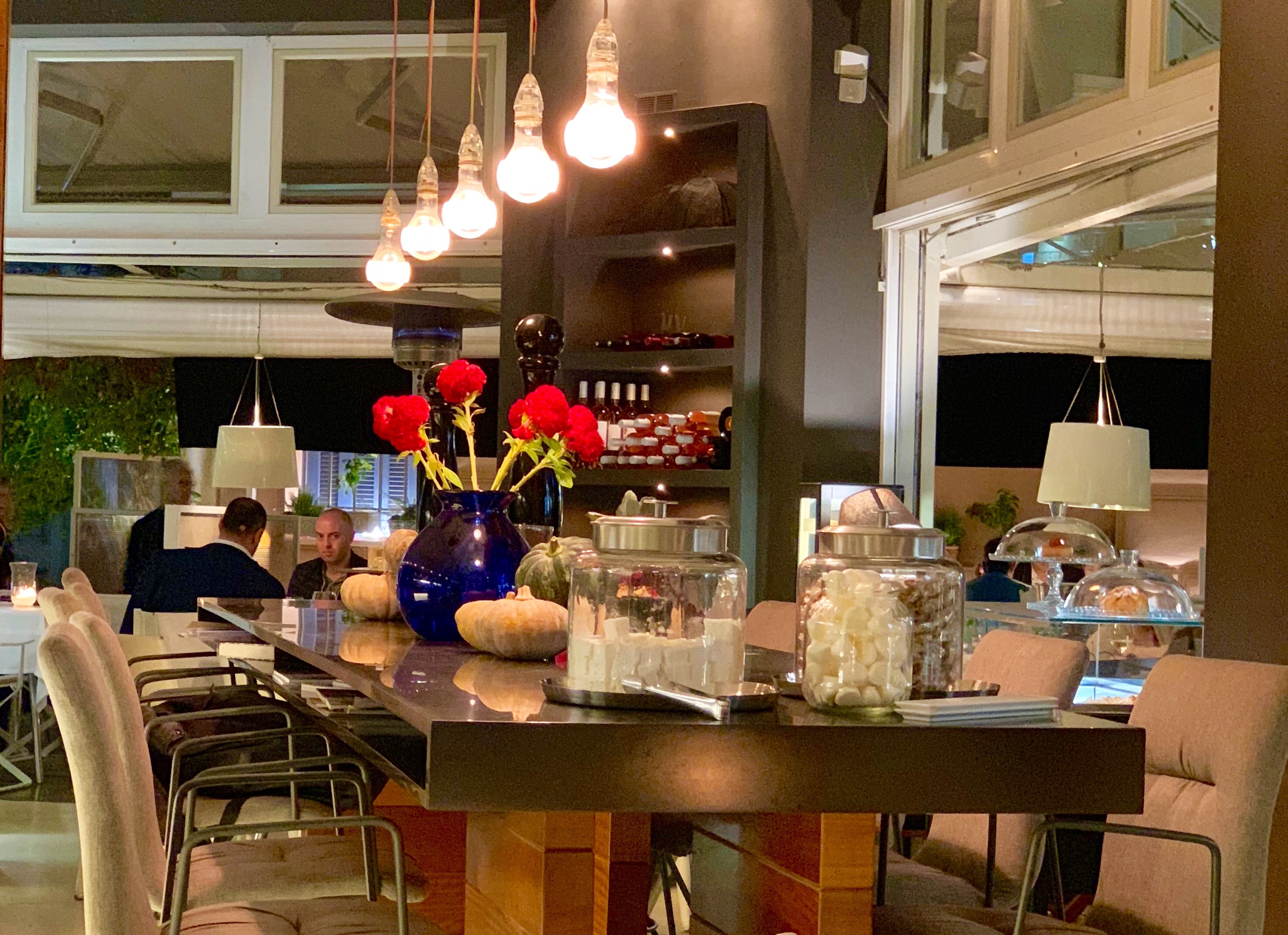
Eat at Milton’s is beautifully designed, with an outdoor terrace, romantic candlelight and interior alcoves for more private dining. Photos by Marla Norman.
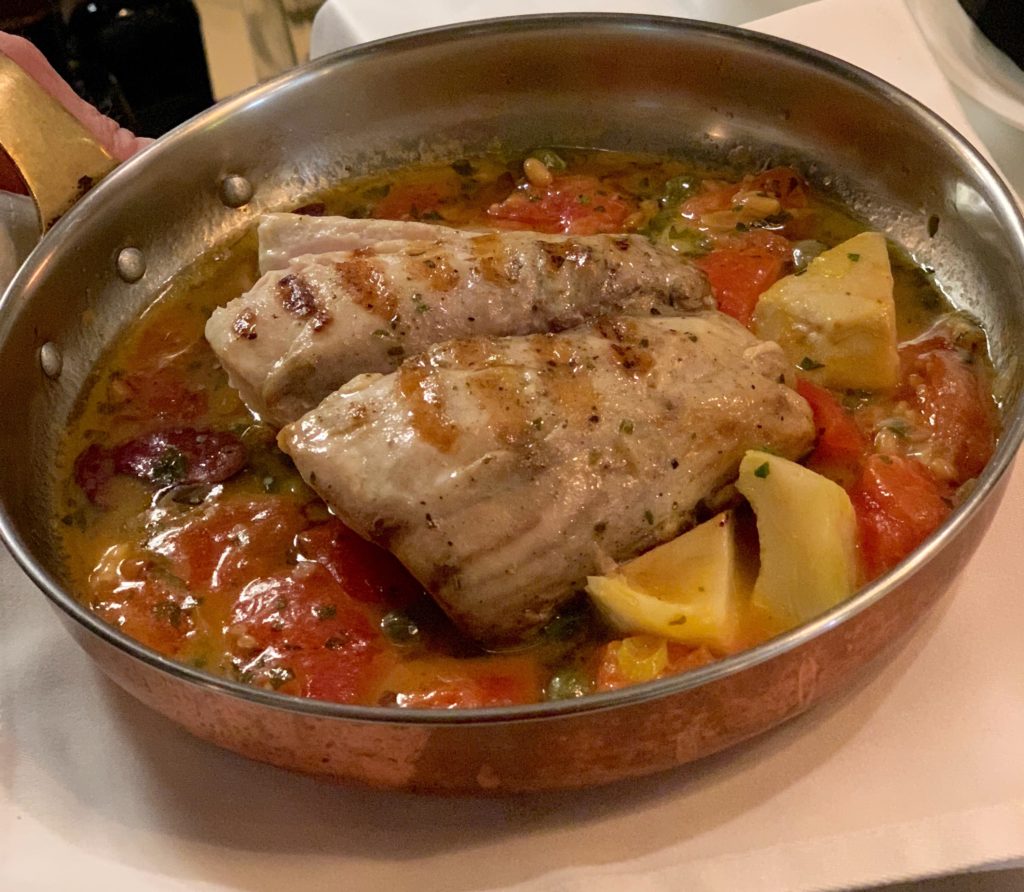
Eat at Milton’s features freshly grilled, superb seafood. Photos by Marla Norman.

An outstanding wine list is one of the many pleasures at Eat at Milton’s.

House-made pasta is annother wonderful option.
Tazza Wine Bar & Restaurant
Petraki 5 & Pentelis
The eye-catching decor at Tazza — swag lamps, paisley cushions, striped awnings — immediately caught our attention. And we throughly enjoyed the salads, lamb gyro and some of the best fried potatoes we’ve had in our lives.
And, our waiter was a delight! When we told him we were from Austin, he broke out in a rendition of Pride & Joy. “Stevie Ray Vaughn is my favorite,” he exclaimed. “Listening to him helps my English.”
I’ll also mention here that, in general, we were impressed with how fluently Greeks speak English. Moreover, we found them to be extremely warm and hospitable — all of which made traveling in their country a joy.
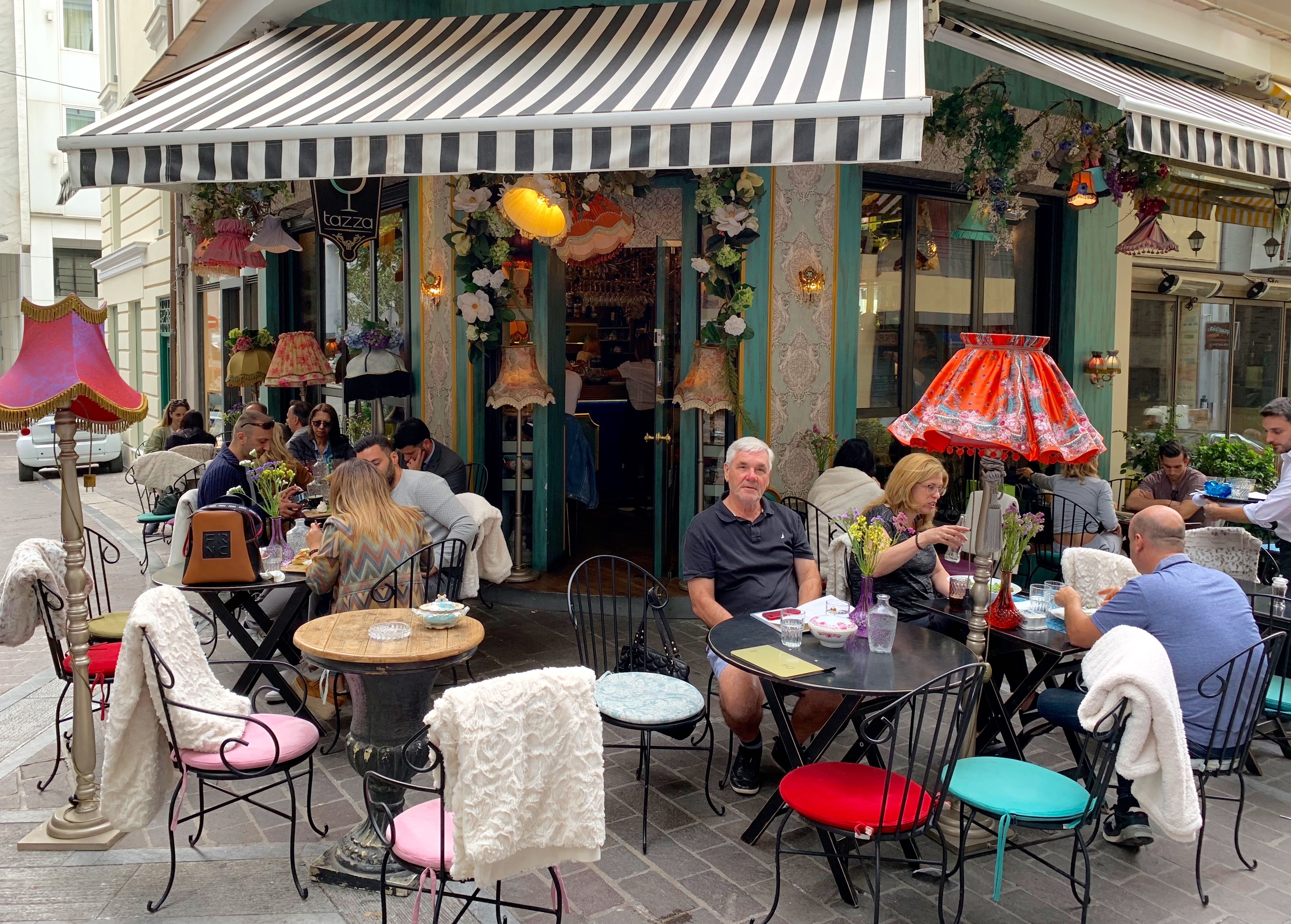
Tazza – Adorable decor, great light menu and personable staff. Photo by Marla Norman.
Scholarchio
Tripodon 14
For a crash course in Greek specialties, Scholarchio (meaning scholarly) is a perfect start. For each course, waiters offer a selection of classic Greek dishes. Prices are a bargain at €3-7 per plate. Diners select as many dishes as they want — rather like a Greek version of Dim Sum. House wine, beer and Ouzo are available as well. There is better food in Athens, but Scholarchio makes for a fun evening and a chance to “educate” your palate in Greek cuisine.
Oinoscent Wine Bar
45-47 Voulis St.
Greek wine production has made great strides in the past decade, but little of the high-quality wines make their way outside the country. Oinoscent offers an exceptional list of Greek wine with knowledgeable staff to assist. If you’d like to purchase bottles, there is a full wine cellar downstairs. A small menu of tasty snacks is also available.
Electra Palace Hotel & Restaurant
Navarhou Nikodimou 18-20
The five-star Electra Palace Hotel offers spacious, comfortable rooms, a professional staff and good rates. The hotel location in central Plaka is outstanding as well. But the top-selling feature would have to be the views of the Acropolis. We found the roof-top bar and restaurant the perfect way to begin every evening. Watching the sun set just behind the Parthenon while lights flicker-on across the Acropolis was an experience to treasure for a lifetime.
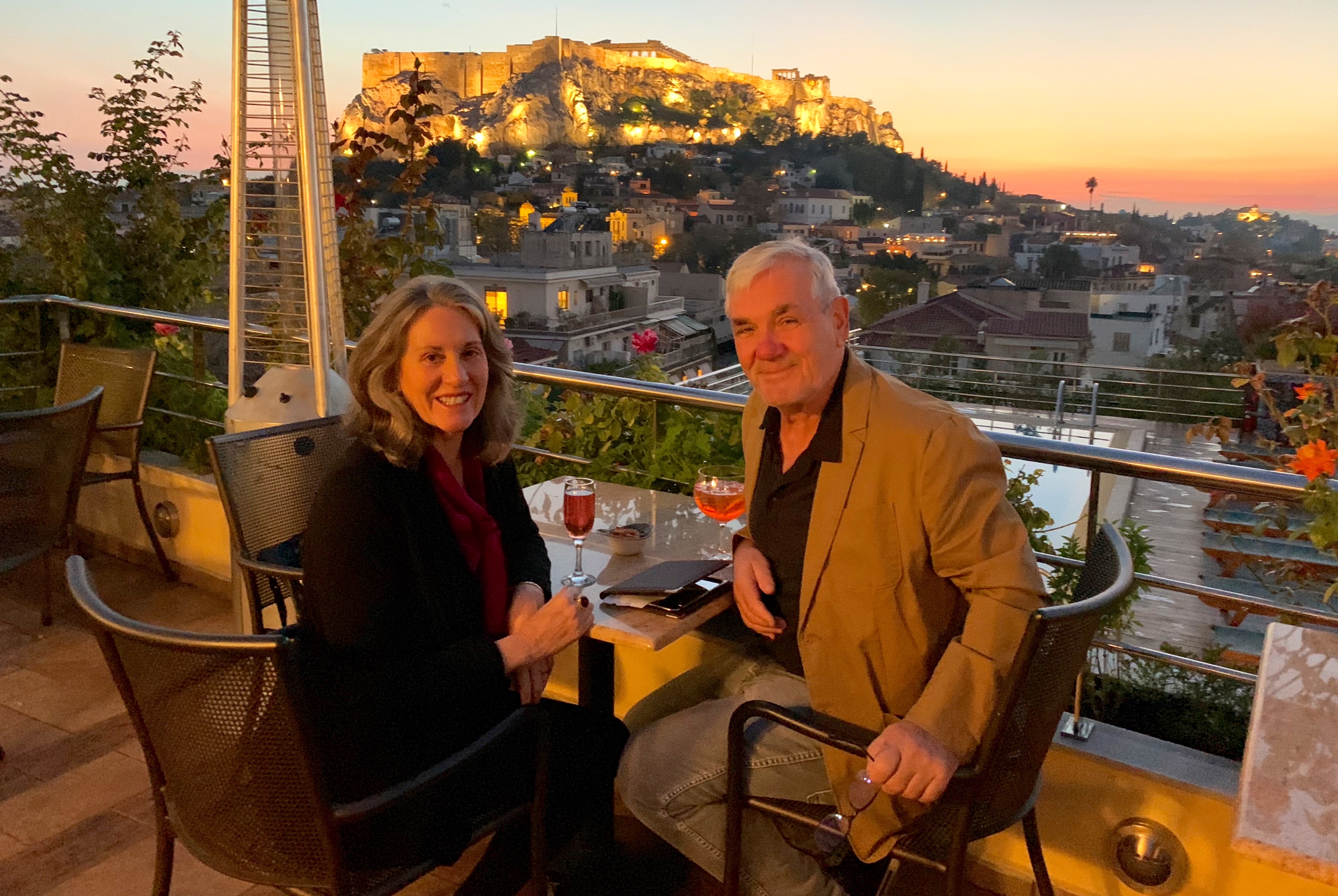
Marla & Michel enjoy a sunset at the Electra Palace & Restaurant in Athens.








